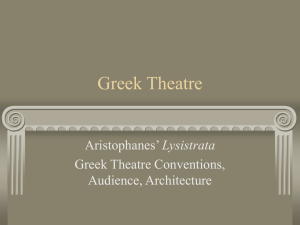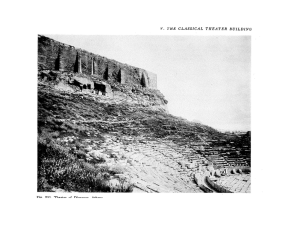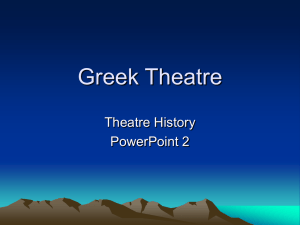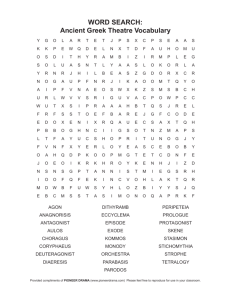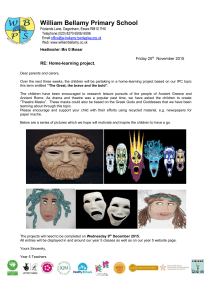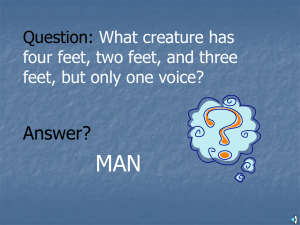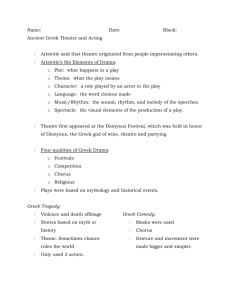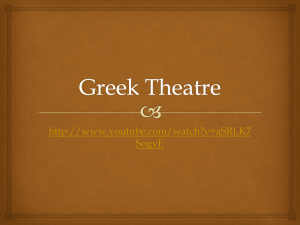Greek Theatre Project
advertisement
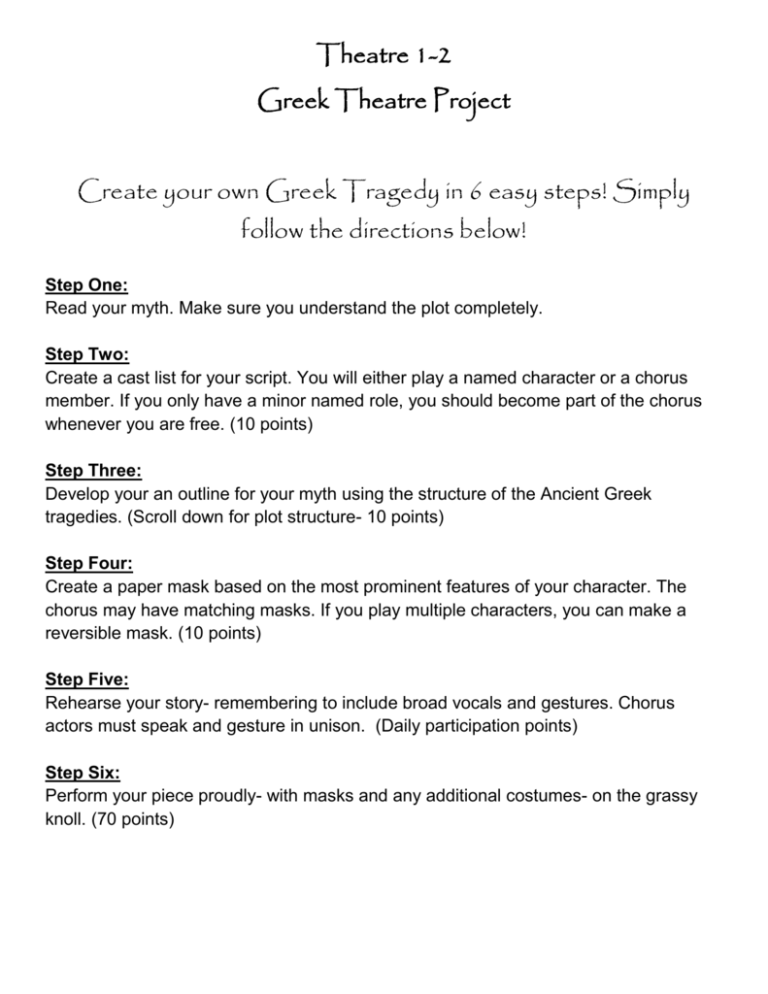
Theatre 1-2 Greek Theatre Project Create your own Greek Tragedy in 6 easy steps! Simply follow the directions below! Step One: Read your myth. Make sure you understand the plot completely. Step Two: Create a cast list for your script. You will either play a named character or a chorus member. If you only have a minor named role, you should become part of the chorus whenever you are free. (10 points) Step Three: Develop your an outline for your myth using the structure of the Ancient Greek tragedies. (Scroll down for plot structure- 10 points) Step Four: Create a paper mask based on the most prominent features of your character. The chorus may have matching masks. If you play multiple characters, you can make a reversible mask. (10 points) Step Five: Rehearse your story- remembering to include broad vocals and gestures. Chorus actors must speak and gesture in unison. (Daily participation points) Step Six: Perform your piece proudly- with masks and any additional costumes- on the grassy knoll. (70 points) Theatre 1-2 Greek Theatre Plot Structure Prologue Characters speak, perhaps directly to the audience. They explain what the play is going to be about. This can also be accomplished through dialogue among characters. Parados Chorus, in unison, tells us what has happened before the beginning of the action of the play. You may select and highlight text directly from your myth or choose to paraphrase and write the choral selections in your own words. Remember, your chorus will be speaking these lines in unison. Episode 1 Characters, in masks, of course, act out the beginning of the action of the play. You can script these lines or use a form of rehearsed improv, where you say generally the same lines from rehearsal to rehearsal. If you want, you can have the chorus interrupt the action to ask questions or make comments. Characters in Greek Tragedy tend to talk a lot about decision making and moral choices. ("What should I do? Am I doing the right thing? etc." Remember that anything violent should take place offstage, with a character or "messenger" entering to tell us what happened. Choral Ode 1 Chorus speaks about something connected with the theme of the story, but not necessarily about the story itself. Or, if you prefer, you may use a popular song or poem here that you think expresses the mood or theme at this point in the play. (In a real Greek Tragedy the chorus would probably also "dance" at this point. If you want, you can have the members of your group dance the movements of the chorus. While dance is not required, broad, unison gestures are a must. Episode 2 Characters act out the next part of the story, again with choral comment if you want. Choral Ode 2 (See Choral Ode 1) (If necessary, you may add more Episodes and Odes here.) Final Episode Characters act out the end of the story. Exodus As or after the characters leave, the chorus tells us what we have learned from the story. Name(s): _________________________________ Period: ___________________________________ Theatre 1-2 Greek Theatre Plot Outline In the spaces provided below, write you’re the lines for your chorus and lines/descriptions for your actors. You may attach extra paper if needed. Prologue:: Parados: Episode 1: Choral Ode 1: Episode 2: Choral Ode 2: Final Episode: Exodus: Theatre 1-2 Greek Theatre Performance Superior (9-10 pts) Excellent (6-8 pts) Good (3-5 pts) Needs Improvement (0-2 pts) Student displays an exceptional level of confidence in lines and blocking. No awkward pauses or indecision is observed. Student excels at basic acting skills, mastering techniques in projection, articulation, blocking, and forms of physical expression. Student displays confidence in lines and blocking. Little to no pausing or indecision is observed. Student lacks confidence in both lines and blocking. Awkward pauses and indecision in action are apparent and plentiful. Exaggerated Vocals Actor demonstrates mastery in both volume and articulation. Actor’s words are broad in tone and of adequate volume to meet the demands of an outdoor performance. The actor, however, is not merely screaming lines. Expansive Gestures Performer uses extreme and expansive gestures throughout the performance. Gestures are broad and exaggerated befitting the style of Ancient Greek Theatre. Gestures relate closely to the dialogue being spoken. Performer uses gestures throughout the performance. However, these gestures lack the exaggerated style of Greek theatre and may not relate to the dialogue being spoken. Performer uses few or some gestures. They are not the exaggerated style of Greek theatre and only have limited relevance to lines being spoken. Commitment to Character Student is highly focused and adds great energy to the performance. A captivating character has been created for the audience’s enjoyment. Tragic structure is followed precisely. Actor demonstrates skill in both volume and articulation. Actor’s words are generally broad in tone and often of adequate volume to meet the demands of an outdoor performance. Vocals are generally consistent. Performer uses extreme gestures throughout the performance. Gestures are broad and exaggerated befitting the style of Ancient Greek Theatre. Gestures may/may not relate closely to the dialogue being spoken. Student stays in character and brings focus and energy to the performance. Student is somewhat confident with lines and blocking. Some pauses and minor indecision may be observed. Student meets the standards of some basic acting skills, including but not limited to projection, articulation, blocking, and forms of physical expression. Several weaknesses may be observed. Actor demonstrates some ability to project and articulate. Actor’s words are sometimes broad in tone adequately loud, but lack consistency in delivery. Student generally stays in character and displays limited energy and focus. Student may occasionally break character. Little focus or energy are present in the performance. Tragic structure is followed sometimes. No evidence of tragic structure. Masks/costumes are present, but detract somewhat from the performance. Masks/costumes are either absent entirely or obscure speaking/movement so much that they become distracting. Preparation Basic Acting Skills Dramatic Structure Masks/ Costumes Masks/costumes are creative and enhance the performance. They befit the style of Ancient Greek Theatre and do not obscure the performer’s speaking/movement TOTAL POINTS = /70 Student masters most basic acting skills, including but not limited to projection, articulation, blocking, and forms of physical expression. One or two weaknesses may be observed. Tragic structure is followed for the most part. Masks/costumes are adequate in style and purpose and contribute somewhat to the performance. Students still needs to meet the standards of basic acting skills, including but not limited to projection, articulation, blocking, and forms of physical expression. Numerous weaknesses may be observed. Actor demonstrates lacks skill in volume and/or articulation. Actor’s words can generally be understood, but lack the broad style of Greek theatre performance. See back for comments!
